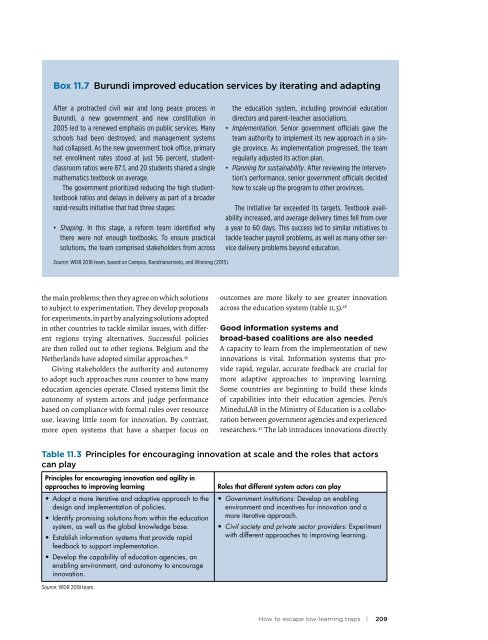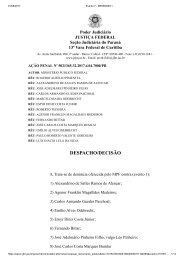Brasil só deve dominar Leitura em 260 anos, aponta estudo do Banco Mundial Relatorio Banco Mundial _Learning
Create successful ePaper yourself
Turn your PDF publications into a flip-book with our unique Google optimized e-Paper software.
Box 11.7 Burundi improved education services by iterating and adapting<br />
After a protracted civil war and long peace process in<br />
Burundi, a new government and new constitution in<br />
2005 led to a renewed <strong>em</strong>phasis on public services. Many<br />
schools had been destroyed, and manag<strong>em</strong>ent syst<strong>em</strong>s<br />
had collapsed. As the new government took office, primary<br />
net enrollment rates stood at just 56 percent, studentclassroom<br />
ratios were 87:1, and 20 students shared a single<br />
math<strong>em</strong>atics textbook on average.<br />
The government prioritized reducing the high studenttextbook<br />
ratios and delays in delivery as part of a broader<br />
rapid-results initiative that had three stages:<br />
• Shaping. In this stage, a reform team identified why<br />
there were not enough textbooks. To ensure practical<br />
solutions, the team comprised stakeholders from across<br />
the education syst<strong>em</strong>, including provincial education<br />
directors and parent-teacher associations.<br />
• Impl<strong>em</strong>entation. Senior government officials gave the<br />
team authority to impl<strong>em</strong>ent its new approach in a single<br />
province. As impl<strong>em</strong>entation progressed, the team<br />
regularly adjusted its action plan.<br />
• Planning for sustainability. After reviewing the intervention’s<br />
performance, senior government officials decided<br />
how to scale up the program to other provinces.<br />
The initiative far exceeded its targets. Textbook availability<br />
increased, and average delivery times fell from over<br />
a year to 60 days. This success led to similar initiatives to<br />
tackle teacher payroll probl<strong>em</strong>s, as well as many other service<br />
delivery probl<strong>em</strong>s beyond education.<br />
Source: WDR 2018 team, based on Campos, Randrianarivelo, and Winning (2015).<br />
the main probl<strong>em</strong>s; then they agree on which solutions<br />
to subject to experimentation. They <strong>deve</strong>lop proposals<br />
for experiments, in part by analyzing solutions a<strong>do</strong>pted<br />
in other countries to tackle similar issues, with different<br />
regions trying alternatives. Successful policies<br />
are then rolled out to other regions. Belgium and the<br />
Netherlands have a<strong>do</strong>pted similar approaches. 45<br />
Giving stakeholders the authority and autonomy<br />
to a<strong>do</strong>pt such approaches runs counter to how many<br />
education agencies operate. Closed syst<strong>em</strong>s limit the<br />
autonomy of syst<strong>em</strong> actors and judge performance<br />
based on compliance with formal rules over resource<br />
use, leaving little room for innovation. By contrast,<br />
more open syst<strong>em</strong>s that have a sharper focus on<br />
outcomes are more likely to see greater innovation<br />
across the education syst<strong>em</strong> (table 11.3). 46<br />
Good information syst<strong>em</strong>s and<br />
broad-based coalitions are also needed<br />
A capacity to learn from the impl<strong>em</strong>entation of new<br />
innovations is vital. Information syst<strong>em</strong>s that provide<br />
rapid, regular, accurate feedback are crucial for<br />
more adaptive approaches to improving learning.<br />
Some countries are beginning to build these kinds<br />
of capabilities into their education agencies. Peru’s<br />
MineduLAB in the Ministry of Education is a collaboration<br />
between government agencies and experienced<br />
researchers. 47 The lab introduces innovations directly<br />
Table 11.3 Principles for encouraging innovation at scale and the roles that actors<br />
can play<br />
Principles for encouraging innovation and agility in<br />
approaches to improving learning<br />
• A<strong>do</strong>pt a more iterative and adaptive approach to the<br />
design and impl<strong>em</strong>entation of policies.<br />
• Identify promising solutions from within the education<br />
syst<strong>em</strong>, as well as the global knowledge base.<br />
• Establish information syst<strong>em</strong>s that provide rapid<br />
feedback to support impl<strong>em</strong>entation.<br />
• Develop the capability of education agencies, an<br />
enabling environment, and autonomy to encourage<br />
innovation.<br />
Source: WDR 2018 team.<br />
Roles that different syst<strong>em</strong> actors can play<br />
• Government institutions: Develop an enabling<br />
environment and incentives for innovation and a<br />
more iterative approach.<br />
• Civil society and private sector providers: Experiment<br />
with different approaches to improving learning.<br />
How to escape low-learning traps | 209








